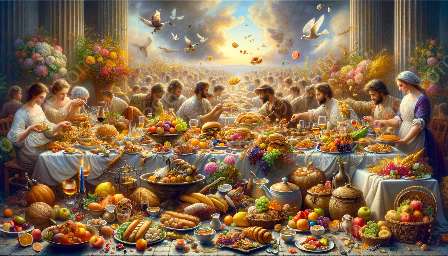Food plays a significant role in the development of characters in literature and art, offering a window into the cultural, social, and emotional aspects of their lives. This exploration will delve into the connections between food and character development, with a focus on the portrayal in different artistic mediums such as literature, visual arts, and performing arts. Furthermore, we will examine how food culture and history influence the representation of characters through food, providing insights into the complex relationship between food and artistic portrayal.
Food in Literature and Art
Food has been a recurring motif in literature and art, serving as a tool for character development, setting the scene, and conveying cultural nuances. In literature, authors often use food to illustrate characters’ personalities, backgrounds, and relationships. For example, the elaborate feasts in J.R.R. Tolkien's 'The Lord of the Rings' not only reveal the hobbits’ convivial nature but also provide insights into the diverse cultures and customs of Middle-earth.
Similarly, art has been utilized to depict the significance of food in shaping characters' identities. Many paintings throughout history have featured food as a central element, presenting the relationship between characters and their dining experiences. The portrayal of meals and food preparation in visual arts provides a glimpse into the societal and cultural norms of different time periods and regions.
Food Culture and History
The role of food in character development in literature and art is closely intertwined with food culture and history. Cultural and historical contexts influence the food choices, dining rituals, and culinary traditions of characters, reflecting their social status, family dynamics, and personal preferences.
Exploring food culture and history also sheds light on the significance of certain foods as symbols of status, power, or emotions. For instance, in ancient Egyptian art, depictions of lavish food offerings and banquets signify the wealth and prosperity of the elite, while in literature, the consumption of specific foods may symbolize characters’ desires, fears, or aspirations.
Character Development through Food
The portrayal of characters’ relationship with food offers a deeper understanding of their personalities, struggles, and connections with their environment. In literature, characters' interactions with food can reveal their values, passions, and internal conflicts. From the indulgent meals of decadent societies to the humble repasts of characters facing adversity, authors use food to enrich the narrative and heighten the emotional impact of their storytelling.
Furthermore, food-related symbolism in art serves as a powerful tool for character development, often conveying underlying themes and motifs. The depiction of characters sharing a meal, preparing food, or indulging in a feast can signify unity, celebration, or turmoil, providing a visual representation of their interpersonal dynamics and societal roles.
Interplay of Food, Culture, and Character
Food in literature and art embodies the interplay of food, culture, and character, capturing the essence of characters' identities within their respective cultural milieus. The culinary elements used to develop characters not only reflect their personal lives but also serve as a lens to explore broader societal issues and historical contexts.
Moreover, the portrayal of characters' culinary experiences allows for a multi-sensory engagement, immersing the audience in the flavors, aromas, and textures that define the characters' world. Whether through the tantalizing descriptions in literature or the evocative visuals in art, the incorporation of food enhances the audience's connection to the characters and their narratives.
Conclusion
Food holds a powerful influence in the development of characters in literature and art, serving as a conduit for cultural exploration, emotional expression, and character development. By delving into the intricate relationship between food, character, culture, and history, we gain a deeper appreciation for the richness and complexity of artistic portrayal. Through the lens of food, characters in literature and art come to life, inviting audiences to immerse themselves in the sensory, emotional, and cultural dimensions of their stories.

